In Part I of this series [1], we presented the data on 400W single ended mogul reflectors, designed primarily to be retrofit into existing canopies. This article continues in a similar vein and presents the data and analysis of lighting fixtures designed for the 150W and 250W Double Ended (DE) metal halide lamps. DE lamps are now more widely used in the reef aquarium hobby and are a very popular option for reef lighting applications, especially for those requiring small overall size or high efficiencies. Lighting fixtures, or luminaries as they are called in the lighting industry, for DE lamps are often sold as completely integrated units with reflectors, sockets, and glass shield mounted in a housing. The ballast may be remotely mounted or integrated within the fixture as in the case of the AB-Aqualine Spacelight. One advantage of these fixtures for DE lamps is that they are often designed very aesthetically and can be used suspended over an open tank, without the use of a canopy over the aquarium.
| Reflector | Ballast | Lamp |
|---|---|---|
| * these reflectors have been discontinued and are no longer in production | ||
| PFO 150W Mini Pendant* | Reliable Ballast | AB 150W 10000K |
| AB 150W AquaSpace Light | Integrated German Magnetic Ballast | AB 150W 10000K |
| PFO 250W Mini Pendant* | PFO HQI Ballast | AB 250W 10000K |
| NEW PFO 250W Mini Pendant | PFO HQI Ballast | AB 250W 10000K |
| AB 250W AquaSpace Light | Integrated German Magnetic Ballast | AB 250W 10000K |
| Sunlight Supply 250W Reef Optix III+ | PFO HQI Ballast | AB 250W 10000K |
The basic methodology and experimental setup is identical to the one used in the 400W reflector study (ref) and details can be read in the part I of this series. The data is also presented in an identical manner with plots for light dispersion for each reflector at distances of 6”, 9” and 12” from the center of the lamp.
One critical difference between Part I and this article is the fact that in Part I, the same lamp and ballast were used with all the reflectors. This allows for a direct comparison without the influence of the ballast or lamp as a variable. Because the AB Spacelight fixture features an integrated ballast and would be used in this configuration we did not try to remove the ballast that came with it. However we did use the same lamp for the tests. The effect of the ballast hence cannot be completely isolated from the raw data, but the % dispersion plots presented help normalize the data with respect to the highest intensity thus reducing the impact of this variable. The % plot can hence also be used to extrapolate the light distribution for different ballast and lamp combinations using the same reflector. Additionally, each of these reflectors is sold with a UV shielding glass built into the fixture. Each reflector was tested with the glass shield that is sold with the reflector. The effect due to the difference in the glass shield cannot be isolated from this data, but once again is captured within the % distribution plots.
In several cases, e.g. the Sunlight Supply and New PFO mini pendants, the same reflector is used with different holders for 150W and 250W lamps. Since the same reflector is being used we only tested these for 250W lamps, since we expect the results for 150W to be quite similar.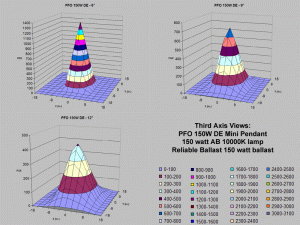
Reflector Data and Analysis
The data plots for each reflector at distances 6”. 9”, and 12” are plotted as a surface graph, top view graph, and a % distribution graph to illustrate the intensity and spread at different points on the measuring grid. Table 2 below shows the list of figures associated with each reflector.
| Reflector | Figures |
|---|---|
| PFO 150W Mini Pendant | Figs. 1-3 |
| AB 150W AquaSpace Light | Figs. 4-6 |
| PFO 250W Mini Pendant | Figs. 7-9 |
| NEW PFO 250W Mini Pendant | Figs. 10-12 |
| AB 250W AquaSpace Light | Figs. 13-15 |
| Sunlight Supply 250W Reef Optix III+ | Figs. 16-18 |
One of the measures of a reflector performance could be its ability to direct light into the aquarium. A reflectors total incident light upon a surface of a given area is representative of the performance of a reflector. It is computed by adding up all the measurements taken at the discrete points within the region. It demonstrates how much light the reflector is able to focus downward when compared to other reflectors with similar operating conditions (same ballast and lamp). Table 3 presents this data for the reflectors in this article.
| Reflector: | Distance: | 3×3 Area | 2×2 Area | 1×1 Area | Maximum PAR: |
|---|---|---|---|---|---|
| PFO 150W Mini Pendant | 6″ | 13620 | 13575 | 12154 | 1347 |
| 9″ | 13423 | 13028 | 9504 | 701 | |
| 12″ | 12778 | 11568 | 6900 | 413 | |
| AB 150W AquaSpace Light | 6″ | 21124 | 20692 | 16975 | 2178 |
| 9″ | 20777 | 18854 | 12383 | 1001 | |
| 12″ | 19178 | 15739 | 8801 | 542 | |
| PFO 250W Mini Pendant | 6″ | 30544 | 30373 | 27016 | 2958 |
| 9″ | 29843 | 28576 | 19786 | 1370 | |
| 12″ | 28927 | 25323 | 14191 | 763 | |
| PFO New 250W Mini Pendant | 6” | 41605 | 41528 | 39946 | 4254 |
| 9” | 41421 | 40770 | 31426 | 2310 | |
| 12” | 39752 | 37333 | 23636 | 1453 | |
| AB 250W AquaSpace Light | 6″ | 43919 | 42966 | 34393 | 4600 |
| 9″ | 41004 | 36532 | 22540 | 1877 | |
| 12″ | 37509 | 29386 | 15928 | 863 | |
| Sunlight Supply 250W Reef Optix III+ | 6″ | 45326 | 44911 | 39202 | 5428 |
| 9″ | 42482 | 39513 | 28244 | 2123 | |
| 12″ | 39298 | 34523 | 20804 | 1176 |
In addition to knowing how much light is incident on a given area, we could also look at how much loss of light occurs on a give area when moving the lamp and reflector higher. Table 4, presents the % of light lost on a specified area as one move the lamp/reflector from 6” to 12” above the surface. A higher % loss would indicate that the reflector is creating a larger spread.
| 3×3′ Area | 2×2′ Area | 1×1′ Area | |
|---|---|---|---|
| PFO 150W Mini Pendant | 6 | 15 | 43 |
| AB 150W AquaSpace Light | 9 | 24 | 48 |
| PFO 250W Mini Pendant | 5 | 17 | 47 |
| PFO New 250W Mini Pendant | 4 | 10 | 41 |
| AB 250W AquaSpace Light | 15 | 32 | 54 |
| Sunlight Supply 250W Reef Optix III+ | 13 | 23 | 47 |
Another metric to analyze reflector performance could be to determine the area coverage of a specified amount of light. Although it is difficult to determine exactly what this specified minimum PAR values should be, we have chosen a cut off of 500 PAR and present the area coverage plots of each of the reflectors in Figures 19 and 20.
One question that is often asked of us is which reflector is the best ?. This is not an easy question to answer as it depends on a lot of variables (shape of tank, height of reflector over the tank, layout of rock work in the tank, etc.), and keeping in mind the objective you are trying to achieve. Clearly, the reflector designs have to balance 2 conflicting requirements – spread v/s intensity. Given that the total light output for a particular ballast/lamp combination is fixed (at any instant), it is the reflector’s job to direct this light. A tight focused beam of light will provide higher intensity over a smaller area, whereas a dispersed output will provide much larger coverage albeit at a lower peak intensity. Depending on your objective whether you want to provide a stron spot light effect on an area of the reef, or want to broadly light a wide area of the tank, different reflectors may be more suitable. Also keep in mind that the reflector spread or intensity can be changed by changing the height at which the reflector is placed above the surface of the water. The objective of these articles is to provide data to allow the reef hobbyist to make an intelligent and informed decision within the constraints of their application and wallets. Within this focus, we will attempt to provide the data that would be useful in making an informed choice.
Rather than focusing on data analysis that any intelligent reader can garner from the data presented in the figures, we will focus on the broader issues and implications. The data shows that the AB spacelight, Sunlight Supply Reef Optix III+, and the New PFO pendant to be good performers as seen from the figures and the data presented in Table 3 and 4. The numbers are within a few % of each other, and possibly within the errors of the experimental setup and measurement. AB spacelight reflector provides a larger spread of light. The best height for all these reflectors seems to be at about 9” from the surface of the water.
An interesting comparison is the one between 250W DE systems and the 400W lamps reflector systems. Since both used 10000K lamps (although from different manufactures, and of different styles), we could try to determine whether we can replace 400W systems with 250W DE lighting system. This would be economically quite beneficial to the aquarist, in terms of savings in power and minimizing heat additions to the tank. Interestingly when comparing the total incident light over the 3X3, 2X2 and 1X1 areas there is only a slight decrease in total incident light, while the lamp power is decreased by 37%. Why is there such a disproportionate difference? One possible explanation could be that the 400W fixtures are not as efficient as the 250W DE fixtures – the small size of the DE lamp allows for better reflector design and allows more of the light to get out of the reflector. With the 400W systems, the larger size of the lamp envelope may be causing some of the light to reflect back into the lamp envelope. Another possible explanation may be that the metric being used (sum of the total light at all the measured points in the specified region) is not capturing this correctly. A better metric may be the integration of the volume under the surface in the intensity distribution graphs. This aspect of the comparison needs to be analyzed further since it has significant practical implications. For now we can make this comparison by visually analyzing the graphs showing the light intensity and distribution.
Conclusion
This article presents the data and a brief analysis of several commercially available double ended metal halide lamp reflectors. The data provided shows clearly the differences between the reflectors, and can provide the user with useful data on the light distribution patterns and shapes, which in turn can be used for purposes of aquascaping, and placement of corals. The issue of area coverage needs to be addressed in a more quantitative manner and efforts are currently underway to determine these areas quantitatively. The computation of the surface integral (intensity X area) as a means of comparison of reflectors also needs to be developed further. Future articles will address this issue, as well as present further results on some additional horticulture reflector that are currently being tested.
Acknowledgements
We would like to thank several people whose help made this study possible. They were kind enough to provide us with lamps, reflectors and ballasts for testing: Patrick at PFO Lighting, Brad at Sunlight Supply, and Aqua Medic.
References
- Joshi, S. and Marks, Timothy. 2003. Analyzing Reflectors: Part I – Mogul Reflectors http://www.advancedaquarist.com/2003/3/aafeature



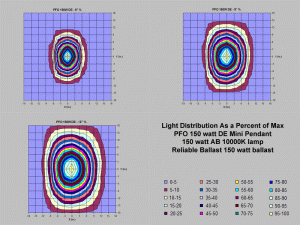

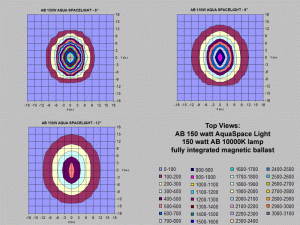
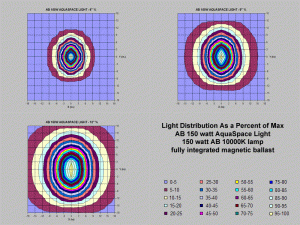
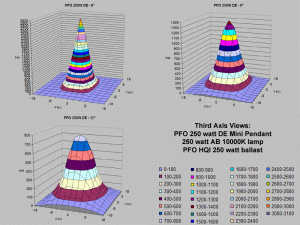
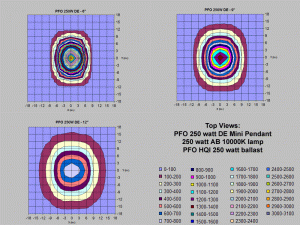
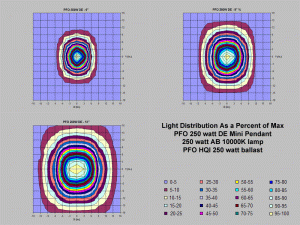
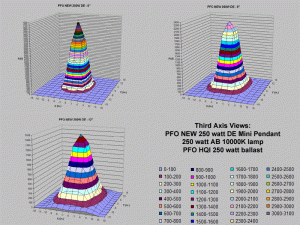

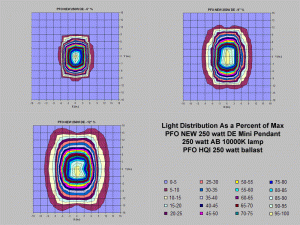

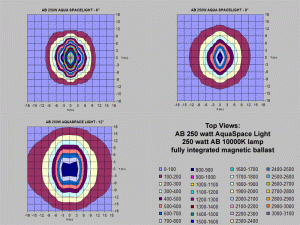
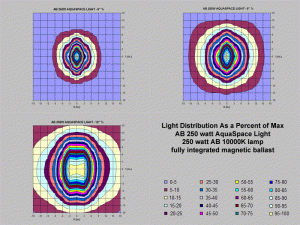
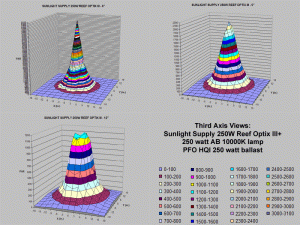
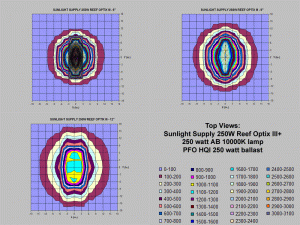
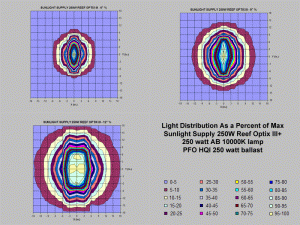
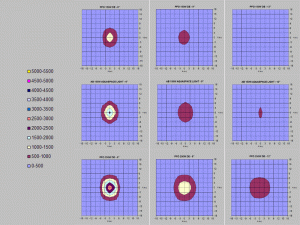
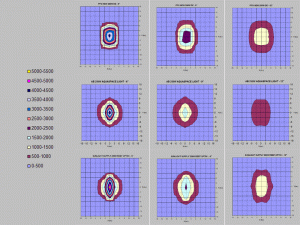

0 Comments